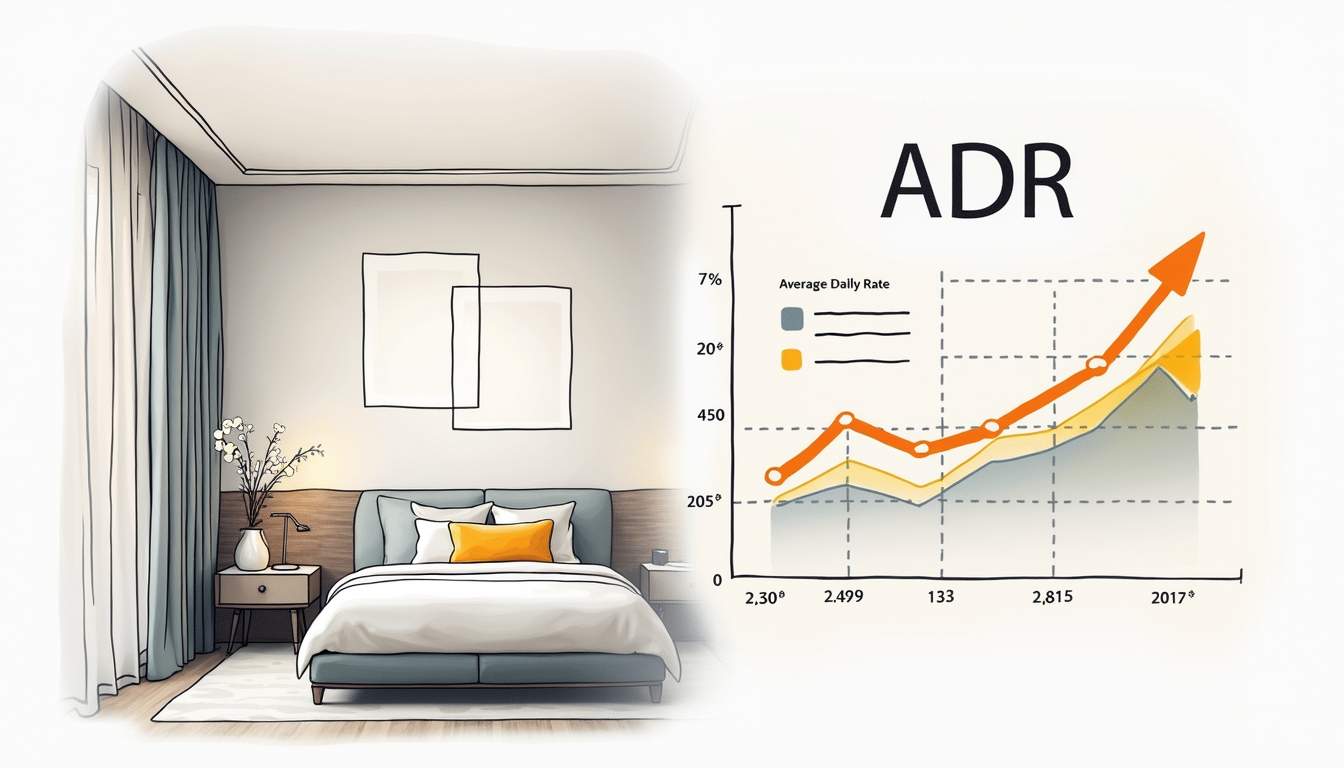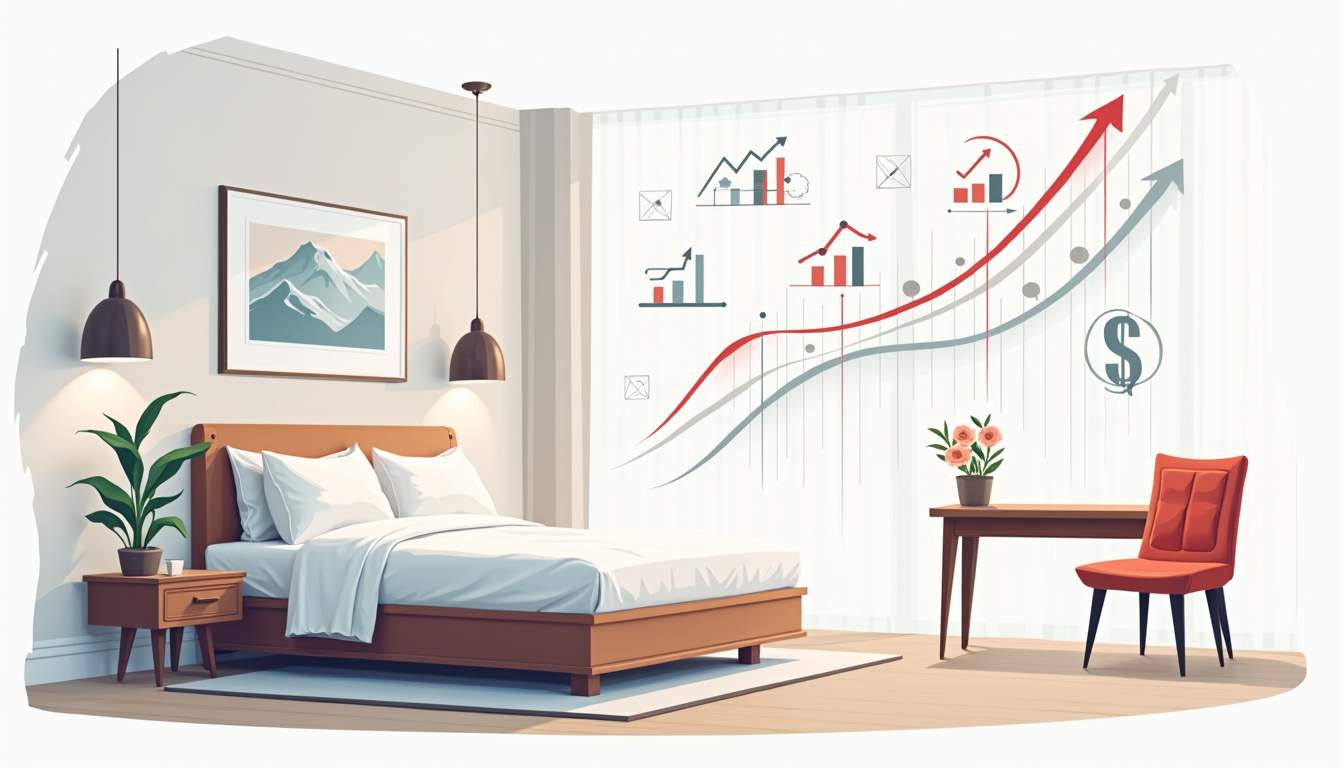Introduction to Average Daily Rate (ADR)
The Average Daily Rate (ADR) is a key performance metric in the hospitality industry, particularly in hotel revenue management. It represents the average revenue earned for each occupied room over a specific period, typically calculated on a daily basis. Understanding ADR is crucial for hotel managers and revenue strategists as it provides insights into pricing strategies, market demand, and overall financial performance.

ADR is calculated by dividing the total room revenue by the number of rooms sold (not including complimentary rooms). This metric serves as a foundational element in revenue management, allowing hotels to assess their pricing effectiveness and make informed decisions regarding rate adjustments, promotions, and inventory management.
In the competitive landscape of the hospitality industry, maintaining a healthy ADR is essential for maximizing profitability. A higher ADR indicates that a hotel is successfully attracting guests willing to pay more for their accommodations, while a lower ADR may suggest the need for strategic adjustments in pricing or marketing efforts.
Calculating Average Daily Rate (ADR)
Formula for ADR Calculation
The formula for calculating the Average Daily Rate (ADR) is straightforward and can be expressed as follows:
- ADR = Total Room Revenue / Number of Rooms Sold
To illustrate, if a hotel generates $10,000 in room revenue over a period and sells 100 rooms, the ADR would be calculated as:
- ADR = $10,000 / 100 = $100
This calculation can be performed over various time frames, such as daily, weekly, monthly, or annually, depending on the specific analysis required. It is important to note that the number of rooms sold should only include those that were paid for, excluding any complimentary or discounted rooms that do not contribute to revenue.
Factors Influencing ADR
Several factors can influence the Average Daily Rate (ADR) of a hotel, including:
- Market Demand: High demand periods, such as holidays or major events, typically allow hotels to increase their rates, resulting in a higher ADR.
- Seasonality: Seasonal fluctuations can impact ADR, with peak seasons often commanding higher rates compared to off-peak times.
- Room Type: Different room types (e.g., standard, deluxe, suites) can have varying ADRs, affecting the overall average.
- Competitive Landscape: The pricing strategies of competing hotels in the area can influence a hotel’s ADR, as hotels may adjust their rates to remain competitive.
Understanding these factors is essential for hotel managers to effectively position their pricing strategies and optimize their ADR. By analyzing market trends and guest behavior, hotels can make data-driven decisions to enhance their revenue management practices.
Importance of ADR in Hotel Revenue Management
Revenue Optimization
ADR plays a pivotal role in revenue optimization strategies for hotels. By monitoring ADR trends, hotel managers can identify opportunities for revenue enhancement and adjust their pricing strategies accordingly. For instance, if ADR is consistently lower than industry benchmarks, it may indicate that the hotel is underpricing its rooms, leading to lost revenue potential.

Moreover, ADR can be used in conjunction with other key performance indicators (KPIs), such as occupancy rate and Revenue Per Available Room (RevPAR), to provide a comprehensive view of a hotel’s financial performance. By analyzing these metrics together, hotel managers can develop targeted strategies to improve overall revenue and profitability.
Benchmarking and Performance Evaluation
Benchmarking ADR against competitors and industry standards is a common practice in hotel revenue management. This process helps hotels assess their performance relative to the market and identify areas for improvement. By comparing ADR with similar properties in the area, hotel managers can gain insights into their pricing effectiveness and make informed decisions regarding rate adjustments.
Additionally, tracking ADR over time allows hotels to evaluate the impact of various marketing campaigns, promotions, and pricing strategies. This historical data can inform future decision-making and contribute to more effective revenue management practices.
Strategies to Improve ADR
Dynamic Pricing
Dynamic pricing is a revenue management strategy that involves adjusting room rates in real-time based on market demand, competitor pricing, and other external factors. By implementing dynamic pricing, hotels can capitalize on high-demand periods and maximize their ADR. This approach requires sophisticated revenue management systems that can analyze data and make pricing recommendations based on current market conditions.

For example, during peak travel seasons or special events, hotels can increase their rates to reflect the heightened demand, thereby improving their ADR. Conversely, during slower periods, hotels may choose to lower rates or offer promotions to attract more guests and maintain occupancy levels.
Value-Added Packages
Creating value-added packages can also enhance ADR by providing guests with additional incentives to book at higher rates. These packages may include complimentary meals, spa services, or local attractions, making the overall offering more appealing. By bundling services and amenities, hotels can justify higher rates and improve their ADR while simultaneously enhancing the guest experience.
Marketing these packages effectively is crucial for their success. Hotels should leverage various channels, including social media, email marketing, and their websites, to promote these offerings and attract potential guests.
Challenges in Managing ADR
Market Volatility
One of the primary challenges in managing ADR is market volatility, which can arise from various factors, including economic downturns, changes in consumer behavior, and unexpected events such as natural disasters or pandemics. These factors can lead to fluctuations in demand, making it difficult for hotels to maintain a consistent ADR.
To navigate market volatility, hotels must remain agile and responsive to changing conditions. This may involve adjusting pricing strategies, implementing targeted marketing campaigns, or even re-evaluating their overall business model to adapt to new market realities.
Data Management and Analysis
Effective ADR management relies heavily on accurate data collection and analysis. Hotels must invest in robust revenue management systems that can track key metrics, analyze market trends, and provide actionable insights. However, many hotels face challenges in managing and interpreting this data, which can hinder their ability to make informed decisions regarding pricing and revenue strategies.
To overcome these challenges, hotels should prioritize data management and invest in training staff to effectively utilize revenue management tools. By fostering a data-driven culture, hotels can enhance their ADR management practices and improve overall financial performance.
Conclusion
The Average Daily Rate (ADR) is a fundamental metric in hotel revenue management that provides valuable insights into pricing strategies, market demand, and overall financial performance. By understanding the intricacies of ADR, hotel managers can make informed decisions to optimize their revenue and enhance guest experiences.
Through effective calculation, analysis, and strategic implementation of pricing strategies, hotels can improve their ADR and drive profitability. As the hospitality industry continues to evolve, staying informed about ADR trends and best practices will be essential for success in a competitive market.
Maximize Your Hotel’s Revenue with Prosper Hotels
Ready to take your hotel’s Average Daily Rate to new heights? At Prosper Hotels, we specialize in elevating your revenue management to its peak performance. With our comprehensive suite of services, including expert revenue management, innovative digital marketing, and streamlined group housing solutions, we are dedicated to boosting your profitability while ensuring the satisfaction and success of your team. Learn More about how Prosper Hotels can help you achieve your hotel’s maximum potential today.


 Drive More Hotel Revenue
Through Untapped Strategies
Drive More Hotel Revenue
Through Untapped Strategies
